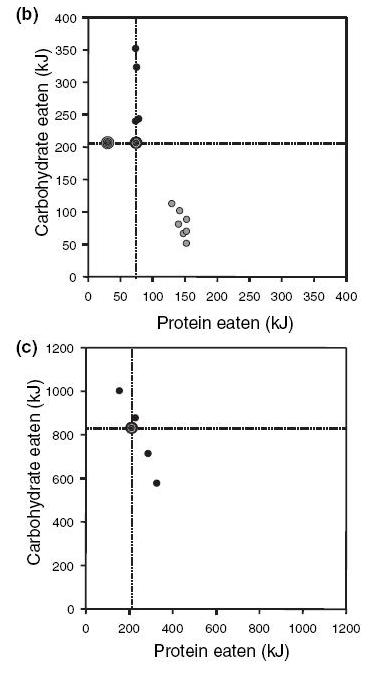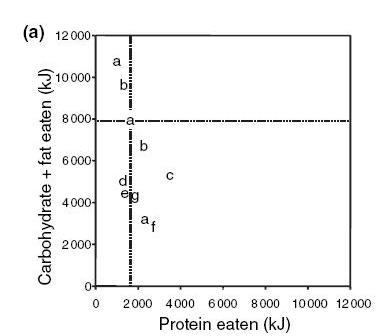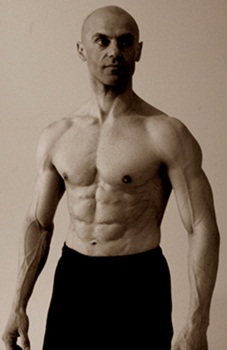Gunther gatherer raised an interesting issue in a comment to Tuesday’s post. Protein may be satiating in the short run; but what about the long run?
[H]igh protein keeps you full at first. But no one really knows for how long. Eventually it stops working and you find you’re eating a lot ON TOP of all the high protein you were already eating. All of us here tried Atkins long ago and fell off the bandwagon more than enough times to know it gets boring, stops working against hunger and doesn’t keep the fat off forever.
I agree. This is why we recommend a version of the normal Perfect Health Diet, which is normal — not high — in protein, for weight loss. Our diet isn’t the quickest way to lose weight, but we think it is likely to work best in the long run.
The Long-Term Effects of High-Protein Diets
I argued in Tuesday’s post that the satiating effects of protein had to be temporary, and that in the long run higher protein might cause, not reduced appetite, but only a slight change toward a leaner body composition.
A more interesting question is: could high-protein diets be positively harmful?
Maybe! Studies in both animals and humans indicate that eating high protein during childhood creates a predisposition for obesity in later life.
For instance, rats raised on a high-protein diet in childhood are more likely to become obese when given calorie-rich (sugar and fat) diets in adulthood. [1] The researchers conclude:
Our research demonstrating a significant susceptibility to an obese phenotype in rats weaned onto a high-protein diet and then challenged in adulthood with a high-fat high-sucrose diet suggests that lasting changes result from altering the composition of the first solid food that is consumed throughout growth into early adulthood. While all rats in this study consumed the same high energy diet during the last 6 weeks of the intervention, distinct metabolic profiles remained evident from exposure to the different diets during growth. This would suggest that these changes, either long-lasting or perhaps permanent, ultimately influenced the adiposity response of these rats to a high energy challenge in adulthood. Overall, it appears that a long-term diet high in protein, when mismatched with a high energy challenge, has negative effects on body mass and hormones and genes involved in glucose and lipid metabolism. [1]
The same phenomenon occurs in humans. In the book we mentioned a study showing that slightly higher protein level in infant formula – 9% protein vs 7% normally – caused children to become overweight two years later. [2]
So parents, let your kids follow their taste buds to high-carb, high-fat diets!
Might adult high protein diets promote later-life obesity too? I’m not aware of evidence, but I don’t think the possibility can be ruled out. I will look for evidence when I do research for two future blog series: one on protein intake, aging, and longevity; the other on connections between obesity and the human aging program.
Can You Be Lean on a Low-Protein Diet?
Tuesday’s post cited research indicating that we have a set point for protein intake: humans are genetically programmed to seek around 360 protein calories per day, and appetite becomes satiated once that is achieved.
But if protein intake determines appetite, then it seems those eating a low-protein diet face a Hobson’s choice:
- If total calories are not increased, then the low protein dieter can expect to have a chronically unsatisfied appetite.
- If total calories are increased, so that appetite is satisfied, then the low protein dieter can expect a higher equilibrium weight and a slightly less lean body.
Is it possible, then, to restrict protein, eat mostly carbs and fat which we know are the ingredients of appetizing desserts – and still achieve a lean healthy body, and feel comfortable?
Yes, I believe so.
Melanesians Do It
Gunther pointed out that Melanesians are lean and long-lived on low protein diets:
I think it would be a bit fairer to include some consideration and explanation of Melanesians and their extremely low protein diet (anywhere from 10% to only 3% protein daily). Their extremely high level fitness and body composition flies in the face of all of these high protein studies.
It’s true: Kitavans, Tokelauans, and other Melanesians eat high-carb and low-protein, yet they’re noted for “extreme leanness.” [3] Why?
Well, first of all, the Melanesian islander diet is a variant of the Perfect Health Diet: it is entirely free of food toxins. As I argued last week, eliminating toxins is the key to healthy weight regulation. But there are other factors.
Coconut Oil
The most abundant fatty acid in the diets of Kitavans and Tokelauans is lauric acid, the 12-carbon fatty acid which is the predominant fatty acid in coconut oil. [4, 5] These shorter-chain fatty acids are ketogenic and have significant effects on the body: for instance, they raise HDL levels. They also make people lean.
In one study, 8 weeks taking 1 tbsp per day coconut oil caused a significant decrease in body weight, waist size, and blood triglycerides. [6] In another, obese women who received 2 tbsp (30 ml) coconut oil per day slimmed their waist and increased HDL without an increase in LDL, while a comparison group receiving soybean oil did not slim their waist and had lower HDL with higher LDL and total cholesterol. [7]
Resistant Starch
Another feature of the Melanesian diet is that the biggest share of calories came from “safe starches” like yams, sweet potatoes, and sago.
These foods have a lot of fiber in the form of “resistant starch.” Digestion of resistant starch by colonic bacteria produces a lot of butyrate, a short-chain fatty acid that strongly promotes leanness.
For example, butyrate improves insulin sensitivity and prevents rats from becoming obese. [8]
Hara Hachi Bu
But the most reliable strategy seems to have been worked out by Asian and Pacific cultures long ago, many thousands of years ago.
The key is that if the diet is well nourishing, then appetite will be mild and easy to consciously control. What will be experienced is not hunger, which indicates malnourishment, but a mild desire for food that can easily be ignored.
There is an ancient Chinese saying:
In Japanese the saying is Hara Hachi Bu, eat until eight-tenths full. Hara Hachi Bu is common practice in Okinawa, where it helped produce the world’s most long-lived population.
As we note in the book, the traditional Okinawan diet is extremely close to the Perfect Health Diet: the Okinawan diet was rich in safe starches and animal fats, and near the low end of our recommended protein range: Okinawans ate about 300 g (2/3 pound) meat and fish per day.
The key here is that on a low-protein diet, eating until eight-tenths full is not a calorie-restricted diet. It is a calorie-sufficient diet that isn’t quite satiating because it is low in protein.
Intermittent fasting is a helpful part of Hara Hachi Bu. Eating only within a relatively short window each day makes it easy to keep calories down.
My Experience
I have been practicing protein restriction for several years, eating coconut oil and safe starches for several years, and practicing daily intermittent fasting for over six months. I drink tea or lemon-flavored water through the morning, and on most days eat only between 2 pm and 8 pm. If I snack during the fast it is usually either a piece of dark chocolate or some coconut oil.
I sometimes go many days eating relatively little, then eat a lot for a few days. Physical activity – sports, intense exercise, running – increases my appetite noticeably. Regardless, I never feel hungry. It is easy to complete the daily fast: some tea, sometimes with coconut oil or dark chocolate, is enough. I now do total fasting on religious fast days – for instance, I now do a 64-hour fast from Holy Thursday through Easter Sunday morning. Generally, as soon as I focus my attention on work I forget that I wanted food.
(This is a very good sign for my health, by the way. During my long chronic illness I couldn’t tolerate fasting at all.)
I haven’t noticed difficulty adding muscle when I work out. I believe I would add muscle more easily on a higher-protein diet, but as it is I add muscle more easily than I used to on the standard American diet. I’m content with my body composition.
Conclusion
I am convinced that by eating coconut oil, getting carbs from safe starches, and practicing intermittent fasting and Hara Hachi Bu, most people can become well-muscled and lean on a low-protein diet without any sense of hardship.
Since a carb-fat mix is the classic recipe for dessert, this makes for an extremely tasty diet.
If you want the surest way to lose weight over the next few days, eat a high-protein diet. But if you want a long-term diet that maximizes longevity by restricting protein, consider eating a tablespoon or two of coconut oil per day, fasting for 16 hours a day, and finishing your meal eight-tenths full.
If you walk a hundred steps after dinner, you just might become a healthy centenarian!
References
[1] Maurer AD et al. Consumption of diets high in prebiotic fiber or protein during growth influences the response to a high fat and sucrose diet in adulthood in rats. Nutr Metab (Lond). 2010 Sep 29;7:77. http://pmid.us/20920272.
[2] European Childhood Obesity Trial Study Group. Lower protein in infant formula is associated with lower weight up to age 2 y: a randomized clinical trial. Am J Clin Nutr. 2009 Jun;89(6):1836-45. http://pmid.us/19386747.
[3] Lindeberg S et al. Haemostatic variables in Pacific Islanders apparently free from stroke and ischaemic heart disease–the Kitava Study. Thromb Haemost. 1997 Jan;77(1):94-8. http://pmid.us/9031456.
[4] Lindeberg S et al. Lipoprotein composition and serum cholesterol ester fatty acids in nonwesternized Melanesians. Lipids. 1996 Feb;31(2):153-8. http://pmid.us/8835402.
[5] Lindeberg S, Vessby B. Fatty acid composition of cholesterol esters and serum tocopherols in Melanesians apparently free from cardiovascular disease – the Kitava study. Nutr Metab Cardiovasc Dis. 1995; 5: 45-53.
[6] Xue C et al. Consumption of medium- and long-chain triacylglycerols decreases body fat and blood triglyceride in Chinese hypertriglyceridemic subjects. Eur J Clin Nutr. 2009 Jul;63(7):879-86. http://pmid.us/19156155.
[7] Assunção ML et al. Effects of dietary coconut oil on the biochemical and anthropometric profiles of women presenting abdominal obesity. Lipids. 2009 Jul;44(7):593-601. http://pmid.us/19437058.
[8] Gao Z et al. Butyrate improves insulin sensitivity and increases energy expenditure in mice. Diabetes. 2009 Jul;58(7):1509-17. http://pmid.us/19366864.















Recent Comments